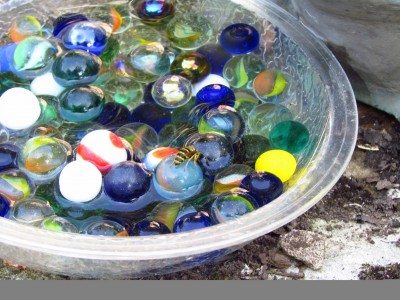Many people think that bees are just scary and mean. (Not all buzzers are created equal).

To most, they are harmless, to others they can be deadly. According to Honey Bee World, approximately 5 percent of our population is allergic to honey bee venom. That’s a small percentage and the severity of reactions varies, but it sure would suck to find out you are allergic by getting stung and not knowing what to do.
But, we need our bees and other pollinators!
Bees are some of the hardest workers on the planet and yet they have such a bad rap. People think that bees are out to hurt them and in fact just the opposite is true!
Bees (and other pollinators) transfer pollen and seeds from one flower to another, fertilizing the plant so it can grow and produce food. Cross-pollination helps the world’s crops and wild plants thrive. Without bees to spread seeds, many plants—including food crops—would die off, which in turn, will kill us! What would we eat? What would the animals the we eat, eat?
But we have a problem with our bees dying off! There is some debate as to the reason, but the facts are the facts. Our bees are dying. According to the NRDC (National Resources Defense Council) in the United States alone, more than 25 percent of the managed honey bee population has disappeared since 1990! This is scary! We need bees and other pollinators to survive.
U.S. crops are pollinated by bees, including apples, berries, cantaloupes, cucumbers, alfalfa, and almonds. U.S. honey bees also produce about $150 million in honey annually.
(That’s a whole lot of sweet goodness)! 
But, fewer bees means the economy takes a hit: The global economic cost of bee decline, including lower crop yields and increased production costs, has been estimated at as high as $5.7 billion per year.
Keeping bees safe is critical for keeping our bellies full, with high-quality produce and it keeps people working.
The good news is that you don’t have to become a beekeeper to help! (Unless you are looking for a new hobby). There are simple things that we all can do to help keep our buzzing pollinators alive:
-Leave those dandelions alone! In colder climates, dandelions are usually the first food for the bees.
-Plant flowers! All our pollinators love them, and they are so pretty for us to enjoy.
-Have a source of fresh water in your yard. I use a glass bowl with colorful marbles in it. It looks pretty, and the pollinators can stand on the marbles to get a drink.

-Bee and butterfly houses are simple to make or can be purchased in most stores. Try a bat house if you live in a tropical or desert climate. Bats are great pollinators in these climates.

-Leave a patch of bare ground and/or a dead limb from a tree (not like an arm or leg) in your yard. They like a place of their own. It also looks natural and makes them feel welcome.
-Most importantly, avoid using pesticides! Not only are pesticides killing our pollinators, they are also finding their way into our drinking water! Yuck! We are basically killing ourselves! That’s just crazy!
We can all do our part to ensure that the bees keep buzzing, the butterflies keep fluttering and our food source doesn’t run out.


There are great new developments regarding the diagnosis of bee ailments described in this recent Economist article:
https://www.economist.com/science-and-technology/2018/03/28/a-new-app-listens-to-the-problems-of-bees
I also learned that bees can be trained quickly and effectively to locate buried landmines!
LikeLiked by 1 person
Well, that is amazing!
LikeLike